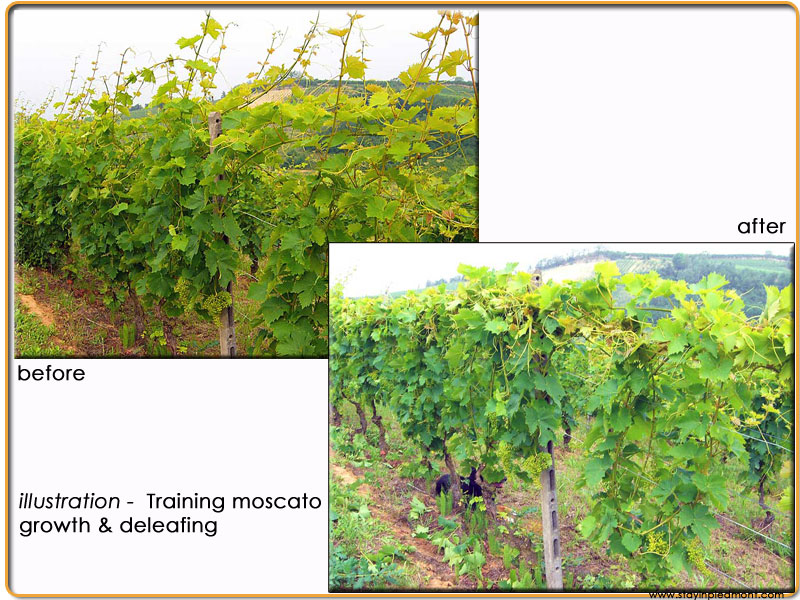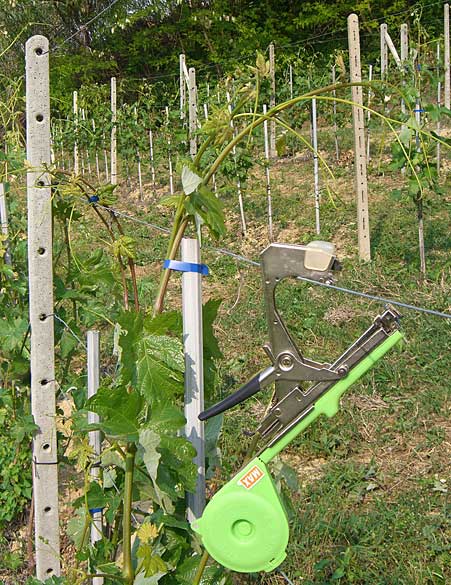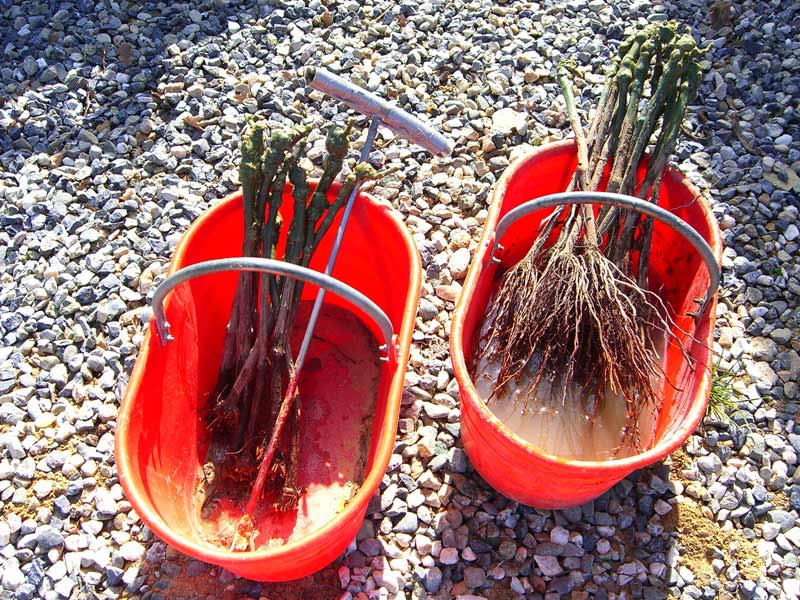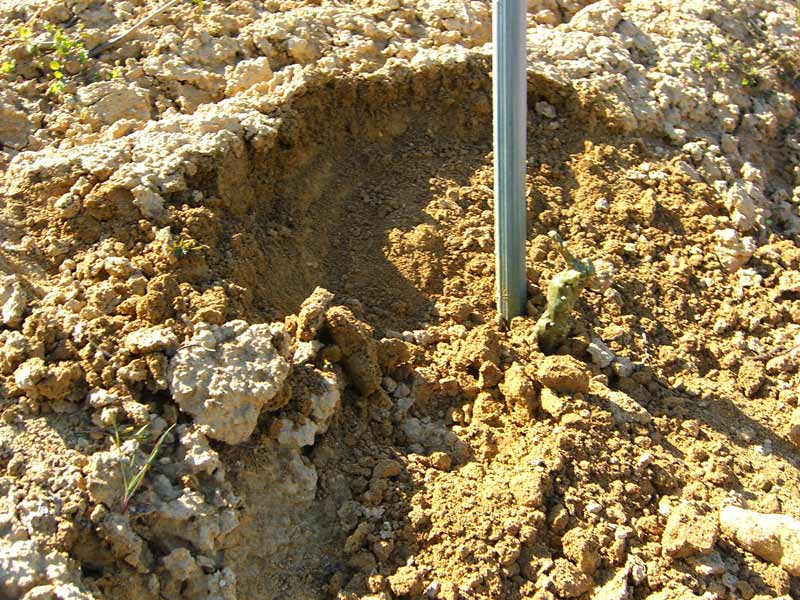VINEYARD DIARY
a month by month account of our progress in the vineyard
2007
December - Well it's not even Christmas yet and the vast majority of our vines are pruned (all of the moscato and a bit more than half of the barbera). The early start was made possible as the vines hibernated early this year (due the the early harvest).
We have also been busy with housekeeping tasks, so the vines that have died for one reason or another have been pulled out (physically, using tractor and chain) and the soil in that location has been turned/loosened to a depth of 1.4 metres. We will plant replacement baby vines in March in these prepared spots.
This will be the first year we have done replacements in the established vineyards so there is more work than would be usual if we adopt an annual replacement regime in the future. (We wanted to do this last year, but time and resources ran out).
Meanwhile a number of trees have been removed around the border of the newer vineyards. Vineyards need as much light as possible and tree roots compete with vines for the moisture in the soil. We can see a great example of this at the most southerly point in our barbera vineyard where a grand old oak dominates the hill and you can see a visible circle of much weaker and poorer vines for about 30m around it. Of course the Oak stays! (I suspect many Piedmont vineyard owners would have the tree down).
November - Leaving Piedmont behind, we spend November in the UK promoting our wines (which are really rather good actually).
October - Usually a month for harvesting and winemaking. this year it is a much less frenetic month and we have started our vineyard maintenance early. We have ploughed those areas in the vineyard that are still under attack from graminia (couch grass) and have prepared our trenches and run offs for winter weather - it seems strange to be this organised.
September - Again ahead of schedule we find ourselves harvesting the barbera d'Asti grapes. This year for the first time our barbera harvest will exceed our moscato harvest, so we have no real idea how long it will take to pick. We start with the new vineyard below the pool (it is now three years old and is producing for the first time). The grapes here are magnificent! Full bunches of plump ripe grapes that taste quite delectus (usually barbera grapes are a little sour to eat, they are after all intended to make wine). They are also more mature than the older vineyards so we start here. Again I would like to thank all the volunteers for their help with this years harvest - including some very kind guests staying in our B&B and apartments.
We also decide to use a technique, new to us, where we collect the bunches into stackable plastic cassettes rather than the brentoni (hydraulic skip) on the back of the cingallo. Using this technique the bunches are not squashed or bruised and arrive in the cantina intact. Thus we drive up the quality of the source for our wine. We are also lucky enough to be able to borrow a friends truck (our friend and builder - Adriano) capable of transporting these containers to our cantina - believe me there are a lot of containers. In fact we have borrowed the containers as well (from our good friend and winemaking. teacher - Roberto Urscheler) , we have 60 containers, the truck can carry a maximum of 50 and we will fill more than 200 in this vineyard alone, so there is a lot of ferrying, weighting, emptying and then rushing back with the empties. You can see some picture of the barbera d'Asti harvest here.
As this is the first week in September it is still very hot so we limit harvesting to the mornings (not for the benefit of the volunteers - but to avoid grapes becoming too warm after picking and before arrival in the vat.
It takes us three and a half days to complete the harvest, on the last day Ingrid and I find ourselves picking alone in the oldest of our vineyards. These is very little left to pick so the two of us start very early and after about 4 hours the harvest of 2007 is complete - there is something very special about working alone in our own vineyards, the early morning sun, birds singing and the knowledge that your grapes are safely harvested and the winemaking. can begin.
August - exceptional year that this is, instead of taking it easy over the month of August we find ourselves in full swing harvesting the Moscato. It takes us two attempts. The forecast for heavy rain is a day away so we decide to try and get all the moscato d'Asti in on one day (throwing a large number of friends and workers at the vineyard) - unfortunately the rain arrives early so by midday we are rained off by the most torrential of downpours (I can't even get the tractor up the hill due to the quagmire of mud - and resort to parking it in the rear courtyard of the farm). We have to wait a week for the ground to dry sufficiently for it to be safe to use the tractor again.
The second August harvest is quick and efficient again aided by family and friends (thank you all) and our belief that this is a great harvest is confirmed by testing as we process the grapes into the holding vats in the cantina. These are the highest sugar levels we have ever achieved and the quality of the bunches is excellent. You can see some pictures of the Moscato d'Asti harvest here.
July
June - Plenty of rain in the last part of May and early June, so our fears about the draught have receded somewhat. The combination of sun, rain and heat (it reached 25 degrees on the 24th May) have pushed the vines to a lot of foliage growth. In the moscato vineyard we are now working to train the height back down onto the top wire of the trellis (see photo's) at the same time we must strip away some of the leaves to allow light to get to the developing grapes and ensure air circulation.
May - 19 May. Today we had to apply a special treatment to the vines as there was a developing threat of a fungal leaf attack. In fact all our neighbours are treating for the same thing - every year we face some kind of "threat" to our vines.
All the vines are trained onto the trellis - in fact we had to do this exercise twice in the 3 year old barbera vineyard as high winds effectively undid all our work (sob).
6 May -We had some great rain last week and fortunately not too much damage to the young shoots that had not yet been supported or tied up.
We are now working full pelt to clean the excess growth off each vine (see illustration). All shoots that are not on the tied down "cane" or the much shorter "renewal spur" must be stripped off entirely. This is done by hand and each shoot is nipped off with thumb and forefinger. The illustration shows a moscato vine.
Here is the best value tool I have bought so far. It is a specialist staple gun that has a biodegradable tape spool in the handle, the action allows one handed attaching of vines (and anything else you want to train up trellis or canes) and has increased the speed of operations about six fold. Price circa 35 Euro.
(1 May) - At long last some rain. Of course now the fear is that the rainstorms tomorrow will be violent and damage the delicate new growth on the vines. The couple of hours of rain we had last night just disappeared (the ground was bone dry at lunch time). Looks like there may be over an inch of rain tomorrow though.
Strapping up the three year old vines (which have now reached the top wire of the trellis!) is done and we are on the ground again - thinning out and strapping up the two year olds. Ohh my back...
April - (25 April) - Things are very busy in the vineyards now! Consistent sun and temperatures in the late 20's has really brought the vines on (still a good 20 days earlier than previous years).
We now have little baby grapes on all the vines and we are working hard on stripping off surplus growth and tying the fine shoots to the trellis. Meantime the youngest vineyard is being weeded (all by hand with a hoe).
In the moscato vineyard I took advantage of a friends visit to enlist some hard labour to trip off a lot of nut tree canopy, we have about 6 mature nut trees scattered in the vines, which causes the shaded vines to perform quite badly.
Today we have undertaken our first verderame, spraying the vines with copper sulphate (to prevent mould and rot type issues), so that means the working season has begun in earnest - next rest after the harvest!
(16 April) The spring has kept us busy in the vineyards and the vines are shooting strongly. I would say we are about 20 days ahead of the same time last year in terns of growth etc. There have been three good series of rain over the past month and that has somewhat relieved our fears after the drought like conditions of last winter.
Currently working on the three year old and two year old vineyards - in both cases putting bracing posts (concrete) at a 45 degree angle to the end post on each line of vines. This helps prevent post movement and sagging of the trellis. In the two year old vineyard we are wiring the trellis for the first time. Once fixed the wires remain permanently in place.
March - Here are a couple of before and after pics of post replacement in the vineyard. In this case it is an end of line (filare) post, these are much bigger (and heavier) than the other posts in the line. (Picture 1 - broken post removed & hole dug by hand - Picture 2 - new post in place and wires re-tightened)
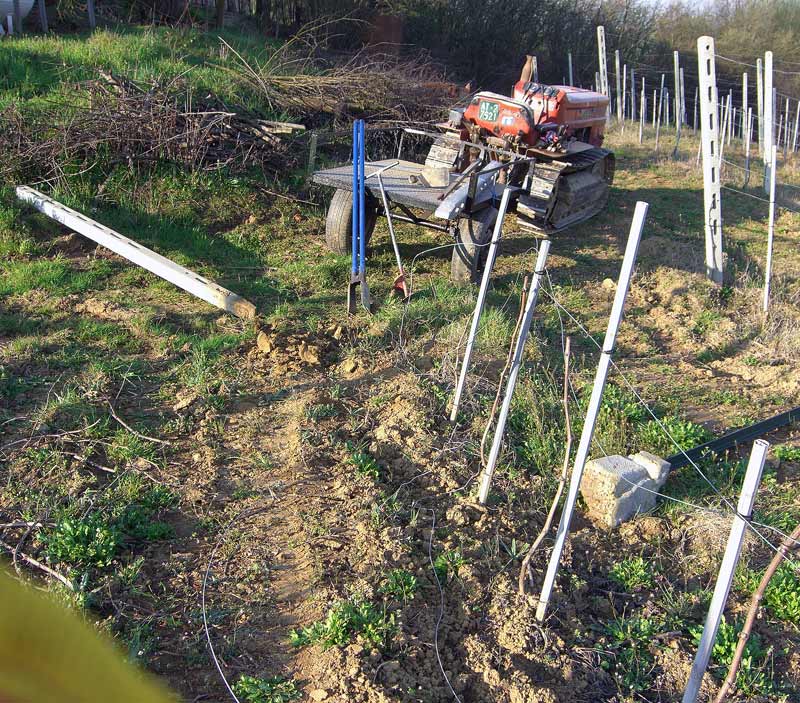
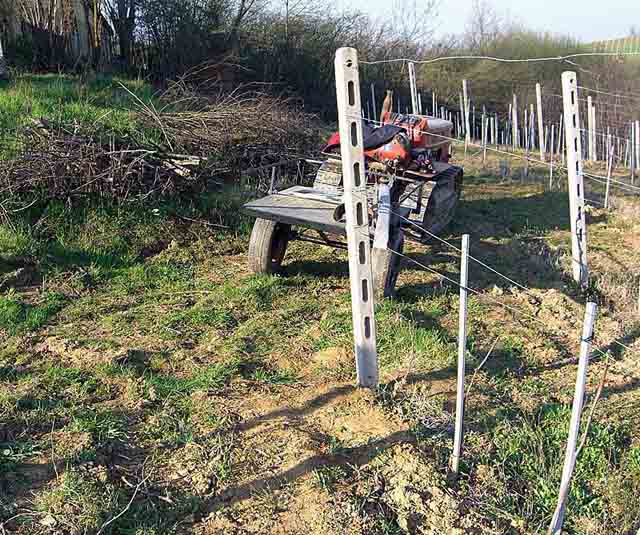
Inevitably some vines will not survive - especially true of the first year or two after planting. So each year at this time we must prepare the ground and replace the dead ones.
Currently we are replacing stock that was planted last year. Actually not a bad attrition this season - I have replaced about 30 (1%) of last years new vineyard. This compared to 350 (10%) for the vineyard we planted in 2005 - so I guess we are learning.
Picture 1 - shows the "barbatelli" nursery reared Barbera vine ready for planting out. With roots on (right basket) and roots trimmed off for planting with the T-bar fork (left basket).
Picture 2 - Freshly planted barbatelli - only a few centimetres showing above the soil.
The remarkable weather continues with bright sunshine and temperature between 15 and 20 degrees. This means that the early spring is well established now with fruit trees that are blossoming and buds blooming all colouring the landscape once more.
We are still "legare" - tying down the pruned vines, which involves gripping and bending the single long spur and forcing it in a bow like shape and connecting it to the lowest wire of the trellis. In the best local tradition we use fresh growth from our numerous willow trees as the "lashing" for the tie down. This is both cheap and environmentally friendly and avoids any damage that can be caused by wire ties cutting through the vine wood.
Complimentary to this is the ongoing task of post replacement and repair. There are a lot of posts (some wood, mainly concrete) and they can be broken by the tractor or other wear and tear... so taking out broken ones and then digging a (substantial) hole by hand is hard but necessary work. I guess I am becoming quite good at it but still lust after hole making tools that can attach to our tractor.
February - Still no sign of rain in the Piedmont, so yesterday we rolled out the cingallo. (it is a small tracked tractor) and attached the trauncher (grass and brush cutting device). Then we drive the combination along each row of vines to cut and mulch all the removed dead canes stripped off the trellis during pruning.
Our machinery is quite old so we are nursing it through each season hoping that nothing major goes wrong as major repairs or new purchases would be a real problem. Yesterday a retaining pin jumped out of the arm attaching trauncher to cingallo., causing us a 30 minute struggle with large wood levers and brute force to remount the bits. In this game you quickly learn field repairs and new skills.
Despite a forecast for rain this week here in Piedmont none has arrived, so we are continuing to prune. The established vineyards were finished last month so we are now focusing on the newer vines.
The barbera vineyard we planted in 2005 will fruit for the first time this year (we had some grapes last year, but did not harvest them). The pruning for the first few years is very different to established vines - so at the moment it's all new to me. We are pruning for height this year - selecting the most upright (straight) cane from last years growth and cutting it at the level of the first trellis wire (2 feet perhaps). On this single upright we are stripping off any buds with the exception of 3 or four, which will form the basis of 3 or 4 fruiting stems. Next year (I think) we will leave almost all of this years cane to continue to grow into the main trunk of the vine.
One good thing about this is that it means less tying down (more on this another time) - where we lash the 2 year old cane to the trellis in a bow like curve - risking eyes and possible whip injuries to the face!
 |
 |
|
|
vines before pruning showing last years growth
|
vines after pruning and stripping off last years growth
|
vines "tied down"
|
January - There are several ways to prune and train vines. As we are governed by DOC & DOCG rules our zone is obliged to use recognised local methods only - in our case this is the well know Guyot pruning system. Grapes only fruit from 2nd year growth and each year we prune away all growth except for one (currently one year old) "cane" and a smaller "spur" that will ultimately become the following years cane. Having read as much as I could about pruning before we started none of this ever made much sense when just sitting and reading.
This is our 3rd winter of pruning our vines, and is probably the first where I am getting the "eye" for how to prune each vine, I am still very slow compared to Edilio, who can prune about 5 vines to my one. On average maybe 2 minutes per vine (we strip off all the old growth later). So multiply this by our circa 12,000 vines.
When pruning one takes into account the past performance of this vine (yes I know - can you remember 12,000 variables) and other factors to decide how many buds will stay on each cane (a bud will become a fruiting cane during the course of the year) - in most cases we currently aim for 6 or 8 ochi. So 6 to 8 grape bunches per vine.
